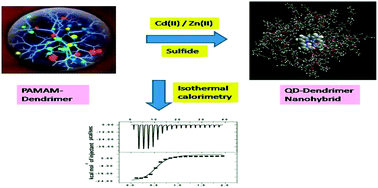Determination of the energetics of formation of semiconductor/dendrimer nanohybrid materials: implications on the size and size distribution of nanocrystals†
Abstract
The synthesis of inorganic–organic hybrid nanomaterials has attracted considerable interest in recent years because of their multifaceted applications, such as in optoelectronics, cellular imaging, drug delivery, etc. The maneuvering of controlling parameters is key to the successful fabrication of good quality materials. However, the fundamental aspects pertaining to the thermodynamics of growth of such nano hybrid materials has so far not been unraveled. Here, we have investigated the energetics behind the formation of semiconductor–dendrimer nanohybrid materials using isothermal calorimetry. It is apparent from the observed energy release profile that the heat change for the formation of nanoclusters in phase II saturates faster with an increase in starting materials or monomer concentrations. We have also shown variation of the thermodynamic parameters with changes in the synthesis conditions, such as temperature, dendrimer generation and dendrimer core or surface groups. Based on a bi-phasic thermogram and the dependence of thermodynamic parameters on the dendrimer core and surface functionalities, it is suggested that nanoparticles are formed inside dendrimer molecules in the initial time period and on the outer surface at a longer time scale. Furthermore, it is observed that the formation of quantum dot–dendrimer hybrid materials is an exothermic, spontaneous and enthalpy driven process. Also, a lower temperature thermodynamically favors formation in the core of dendrimer molecules leading to smaller particles with a narrower distribution. The observed results suggest that higher values of formation constant and enthalpy are likely to make dendrimers of higher generation better templates for the synthesis of nanoparticles. The dependence of the ratio of concentrations of reacting metal ions (Cd or Zn) to sulfide ions shows a differential size pattern for CdS and ZnS nanoparticles, which has been interpreted in terms of binding constants determined calorimetrically. It is shown that enthalpy–entropy compensation takes place in the synthesis process affording favorable free energy. Such investigation can provide useful guidelines for the synthesis of better quality semiconductor–dendrimer hybrid nanomaterials.


 Please wait while we load your content...
Please wait while we load your content...